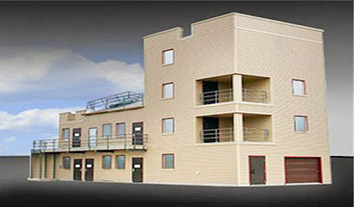Subscriber Benefit
As a subscriber you can listen to articles at work, in the car, or while you work out. Subscribe NowHamilton County commissioners are pushing to build a countywide public-safety training campus that might eventually cost more than $40 million. But the County Council is lukewarm about the project and is pushing back against the commissioners’ request for the first $3 million, to build a training facility.
The board of commissioners—the three-member executive branch of Hamilton County government—and virtually all the county’s elected and public safety officials agree the facility to be built on 96 acres near 161st Street and River Road in Noblesville would allow police, firefighters and other public safety workers to spend more time training.
But most county council members say the cities and townships should absorb more of the cost.
“It’s easy enough to be for it when someone else is paying the bill,” council member Fred Glynn said.
Another sticking point has been that the county isn’t responsible for fire protection. The county operates the sheriff’s department and the jail, but fire services are left to the cities and townships.
 McKinney
McKinneyCouncil member Rick McKinney said it’s like asking a rich uncle to pay for a niece’s or nephew’s college education.
“We love our neighbors. But are we responsible for paying their bills?” McKinney asked.
Westfield officials first proposed a public safety training complex 25 years ago, and in 2009 Westfield and Fishers received grant funding to get the ball rolling. In 2011, a master plan commissioned by Westfield called for spending as much as $42 million on a complex. The first phase, now projected to cost $3 million, includes a multistory fire tower, gun ranges, classrooms and a live training facility that would allow firefighters to practice controlling real fires.
The long-term vision includes more equipment for fire and police, plus infrastructure for homeland-security and emergency-response training. No time line has been set. Some of the most expensive components of the master plan are a shoot house, police training facility, canine academy, observation tower and office complex, and the homeland-security training facility.
Though the land is in Noblesville, it is owned by Westfield. As part of the transaction last year to privatize Westfield’s water and wastewater utility, which previously owned the property, Westfield retained ownership of 45 acres. To fulfill the master plan, additional land would need to be acquired.
The county council is the last entity needed to greenlight the project. It is being asked to cover the $3 million for the training building’s construction, plus a $40,000 annual share in operating costs.
Carmel, Noblesville, Fishers and Westfield each have approved $40,000 in annual operating funding. The cities would not pay for infrastructure or construction in the initial phase.
The commissioners spent about an hour recently discussing how to best respond to councilors’ concerns.
 Dillinger
Dillinger“If [the county is] putting up the $3 million, why do we have to put up [another] $40,000 [annually]?” Commissioner Steve Dillinger asked. “You have to have an answer for that.”
Commissioner Christine Altman said all county taxpayers would be contributing to bond payments, so the county should take on the $3 million capital cost.
 Altman
Altman“They’re not being logical in my opinion,” Altman said of the council members.
“I’m playing devil’s advocate,” Dillinger said. “Why should [the cities] not split the capital costs as well?”
County council member McKinney said he’d like to see the capital costs split 50/50, with the four cities offering $1.5 million combined, and the county providing the other half.
Glynn, longtime council member Brad Beaver and President Paul Ayers also want the funding divided more evenly.
“If it’s that important, I think the entities responsible for it will come up with the funding for it,” Glynn said.
Altman argued at the commissioners’ meeting that all county residents would benefit from highly trained public safety officials.
“It’s a no-brainer,” Altman said. “You just have to refute it with the best logic we can.”
Council members say they’ve received no documentation outlining expenses or an operating plan.
“We need to be informed,” McKinney said. “We need to be brought into the loop.”
Beaver said it’s uncommon for a large project like the training center to come before the council last instead of first, especially when the council is being asked for the greatest amount of money.
“Shouldn’t you start at this end and go the other way?” Beaver said. “Usually, whoever’s paying the piper is the guy at the front.”
Council members also cite training centers in nearby Wayne Township and Lawrence in Marion County as a reason against approving the project. Supporters argue the new facility would allow emergency responders to train more often and would reduce travel costs.
The commissioners stressed that the $3 million commitment does not hold the council to future funding, and that cost can change over time. Projections for the firearms training ranges and yard rifle range have increased since the master plan was prepared, for example, and the estimate for the range house has decreased.
“There’s nothing contractual that requires us to spend another dollar on capital,” Altman said. “To me, you can’t govern based upon what-ifs.”
The county also has other expensive projects in its pipeline, including improvements to State Road 37 and a possible jail expansion.
“I’m for firefighting training. I’m for public safety training. But, again, am I responsible for it?” McKinney asked. “My answer right now is no.”
An informal meeting where the commissioners will present the master plan hasn’t been scheduled, but is expected to occur in June. No date is set for the council to officially consider the matter.•
Please enable JavaScript to view this content.

